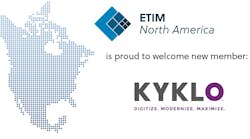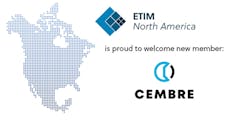The IDW Age in the electrical industry is moving swiftly toward dawn. By all indications, it looks as though the industry data warehouse (IDW) will be ready to go live sometime in the second quarter of this year. >From an operations standpoint, the deployment of the IDW could be one of the most profound developments in the history of electrical wholesaling, because it proposes to bring to the electrical industry one of the most fundamental and powerful elements in the pursuit of lower-cost transactions: Clean, synchronized product data.
How powerful is this concept? The proponents are not shy. By putting an end to the hassle, the delay and the expense of errors made keying information by hand, by putting an end to the wasted cost of supporting a host of incompatible formats for exchanging data between suppliers and distributors, and by removing a major obstacle from the development of new business software features, they say it could multiply the value of your current and future investments in information technology. They say it could make the full benefits of electronic commerce available throughout the electrical market channel. They even say it could raise the bar in the competition among wholesale channels, making electrical companies the unrivalled leaders in taking products to market efficiently and effectively.
At least, that's the idea.
The IDEA is also the association charged with making the IDW a reality. (It's an acronym for Industry Data Exchange Association.) Formed early last year by a joint effort of the National Electrical Manufacturers Association (NEMA), Rosslyn, Va., and the National Association of Electrical Distributors (NAED), St. Louis, Mo., the IDEA has taken the idea of data synchronization and built an apparatus that will make it come alive. The association's committees did this, navigating the ancient shark-infested political waters of the industry's vested interests, and have thus far brought it off so thoroughly, with the enthusiastic backing of so many industry heavyweights, that naysayers are scarce.
In the next few months, the industry will get to see the first attempts at turning this vision of synchronized data into an actually functioning system. How soon the benefits will begin to accrue is anybody's guess-there are many organizations and many systems that must be made ready and many obstacles yet to clear-but at the very least the industry as a whole will get to start working with some truly new ways of doing business. Here's how it works:
The IDW project, in a nutshell, is a plan for taking all the data relating to products made by electrical manufacturers, making those data conform to a standard database format and transferring them to a central repository. From that repository, electrical distributors and other resellers can collect data on all their suppliers' products and load them onto their business systems. The data are updated at least daily by the manufacturer and retrieved at least daily by the distributor. The process must be seamless, transparent, secure, and automatic, meaning at no point along the route are the data subjected to a human's potentially contaminating touch.
The IDEA Technical Committee began with the Product Descriptor Database (PDD) salvaged from the wreckage of the AnswerPro project, the industry's first attempt at putting together an electronic catalog by consensus. The technical committee, led by co-chairs John Haluska, chief information officer of Thomas & Betts Corp., Memphis, Tenn., and Jim Ford, electronic commerce director of Graybar Electric Co., St. Louis, Mo., over a period of several months, expanded and refined that database into some 119 fields, which they then divided into 17 "Views," and prioritized them according to their importance to a distributor trying to conduct business.
The committee designated "Primary Commerce Fields" most of the data describing and identifying the product, including manufacturer product numbers, UPC numbers, invoice descriptions, bar codes, seller classifications, published price categories, package dimensions and minimum and optimum order quantities. These are the fields that will be filled or "populated" within the database first. They are enough for a distributor to transact business. These are the kinds of data IDEA's manufacturer members are now concentrating on being able to provide to the IDW in the standard PDD format and that IDEA's distributor members and their software vendors are concentrating on being able to integrate into their systems by the time the data warehouse is officially brought online. The fields that fill out the rest of the database include things like technical help numbers, MSDS sheets, Web sites and other data pertaining to the product and its application. "Fluff," says Haluska, "but good fluff."
The data will be sent from manufacturer to IDW and from IDW to distributor using industrywide EDIPro and ANSI X12 standards, primarily specified variations on the 832 transaction set. Once received by the IDW, but before being accepted into the database, the data go through a "data scrubbing" routine designed to kick back obvious errors in format or value, such as a 16-digit UPC number or a 1,000-fold price increase. The non-conforming data fields are sent back to the manufacturer, who has sole authority to alter the data. Once they pass muster, the data are ushered into a Sun Microsystems E5500 enterprise-class server running an Oracle database, housed at the Livermore, Calif., headquarters of CCI/Triad Systems Corp. Triad manages the data warehouse system, including implementation, testing and technical support, under contract to the IDEA.
The distributor's contact with the IDW itself is blind retrieval. There are no browsing functions in which a distributor inside salesperson could shop prices against those carried by his competitor's suppliers. A distributor's authorization for access to a manufacturer's data is controlled entirely and exclusively by the manufacturer.
Connection to the IDW is an area where technical details are still vague. One clear option is to send and receive transactions via a traditional EDI value-added network provider (VAN). But VANs' fondness for pricing their services based on the volume of characters that pass through their hands could make full use of the IDW prohibitively expensive. An MIS director under budgetary constraints, whether he's a manufacturer or distributor, has to cut corners and limit the amount of data sent or received if he's paying by the kilocharacter (the standard pricing unit for a VAN). This is a powerful incentive to maintain incomplete data, which destroys the fundamental reason for building a data warehouse in the first place.
Many involved with the IDW looked at the Internet as a potential alternative to VANs. But security issues, bandwidth bottlenecks and potential vulnerability to hackers raised serious concerns. (Some skeptics note that this doesn't stop Amazon.com or online stock traders from using the Internet for mission-critical exchanges.)
For those and other reasons, IDEA is in the advanced stages of negotiations with a company IDEA officers refuse to name. The subject of the negotiations is the construction and management of an industrywide extranet.
Essentially a stand-alone frame-relay telecommunications network that is connected to the public Internet only through a firewall, the extranet would allow subscribers to send and receive data using Internet protocols (IP) as well as EDI standards in a secure environment with practically unlimited bandwidth. It would be under industry control, with the ability to prioritize business transactions so mission-critical data always got through first. An extranet could also carry users' telecommunications traffic and other communications, all for a flat monthly fee.
Despite the fact that they have no deal in hand, IDEA's leaders expect to have an extranet in place in time for the system to go online. The deadline they're watching is the end of April, this year. The association seems certain that its apparatus will be ready in time.
The big question is, who will be ready to use this system once it's available? At press time, 62 manufacturers and 142 distributors had joined IDEA. Those numbers may represent only a small part of all the manufacturers and distributors making and moving products in this industry, but they do include the largest manufacturers and distributors in the country, and IDEA officials estimate that those companies account for 80% of the industry's total dollar-sales volume.
The actual IDW system has been undergoing field tests of its data receiving and scrubbing operations since early in January. According to Steve Bieszczat, senior director of information services for the Hardlines & Lumber division of Triad, who oversees the IDW project, the system is on schedule for beta tests in early February. In the alpha phase of testing, two manufacturers, Lithonia Lighting, Conyers, Ga., and Thomas & Betts, sent data to test whether the system behaved as well in real life as it had in the programmer's imagination.
Manufacturers have a lot of work ahead of them, especially those with multiple facilities that don't have data integrated in one place. Some of the manufacturers are taking a divide-and-conquer approach in their preparations to populate the IDW, assigning teams of non-technical people to gather data so IT specialists currently tied up with Year-2000 (Y2K) issues can just come in and concentrate on the programming, says Paul Suzio, vice president of EGS Edwards Signalling, Cheshire, Conn., and co-chairman of the IDEA Marketing Committee.
Other manufacturers are outsourcing some of the work. Trade Service Corp., San Diego, Calif., has a contract with IDEA to provide manufacturers and distributors with transitional services to help them collect, organize and translate their data into the IDW format. This will "alleviate any concern a manufacturer may have about Y2K impacting its ability to participate in the IDW in a timely and cost-effective manner," says Norm Decker, vice president and general manager of Trade Service.
Third-party software packages that gather and organize data for the IDW have also emerged. Profile Systems, Inc., Holyoke, Mass., for example, has a product called ProSync that can collect product data from throughout the manufacturer's operations and make them conform to PDD standards for transmission to the IDW.
As the upstream, manufacturers' side of the IDW system moves into beta testing, the downstream side is entering the alpha-test stage. Tests were planned for early February with NxTrend Technology, Inc., Colorado Springs, Colo., which would be the first of the suppliers of distribution software packages to put the IDW's information retrieval and transmission functions through their paces.
Distribution software providers have one of the most critical roles to play in the IDW's initial success, says Dave Crum, president of Crum Electric Supply, Casper, Wyo., and chairman of IDEA. They must be ready to offer distributors an interface capable of capturing data from the IDW and integrating it into their business systems. If they're not ready in time for the IDW service's debut, all that wonderful data will be unavailable to the vast majority of distributors who rely on outside software packages. Seven of the software vendors active in the industry have stepped up and committed to having their distributors ready to use the IDW by the time it goes live. This feat will take a substantial effort on their parts, with resources taxed by Y2K upgrades and programming talent at a premium, but the companies say the importance of the IDW project can't be overlooked. (See "To Beat the Clock," page 29).
Distributors whose business systems were developed in-house by staff IT programmers are at an even greater disadvantage getting ready to use the IDW service. "I don't think any of them will be ready in time," says Crum. To help them prepare, IDEA's technical committee has organized a work group that will bring together IT specialists from these distributors with IDEA and Triad technical people to pool their resources and help them come up with effective IDW interface systems.
While the technical groups prepare the system, IDEA's marketing committee is preparing to put the word in the streets about the IDW. The IDW's influence is expected to extend far beyond the traditional boundaries of the electrical industry-IDEA membership is open to all resellers of member manufacturers' products and all suppliers of product to distributor members-but the initial promotional campaign will take place within the traditional electrical organizational structure, says Suzio. The group is hosting informational sessions and implementation seminars at NAED's regional and national meetings this year, and a video promoting the IDW will add some punch.
IDEA has also formed a certification committee that will certify manufacturers and software systems as IDW-compliant. Certifications will be awarded in four levels ranging from expressed intent to comply with the service's standards to tested and fully functioning participants. This committee had its first meeting last month, but members say they will be ready to certify by the end of March.
Members of IDEA's operating committee, headed by chairman Crum and vice chairman Clyde Moore, chief executive officer of Thomas & Betts, have surprised even themselves with the support they have been able to win from major players in the industry. The association has raised over $6 million toward development costs with no product to show up front.
To join IDEA and utilize the IDW, distributors pay a one-time membership fee that's based on their annual sales in the U.S. and Canada, as well as a yearly usage fee. Manufacturers also pay a one-time membership fee. It's based on their total sales through resellers of electrical products in the U.S. and Canada. The annual fee for manufacturers will be about 5% to 10% of that membership fee to cover software maintenance and upgrades.
The operating committee has some political issues to resolve as well. Under the present bylaws, there is no provision for manufacturers' representatives to access data directly from the IDW. An oversight caused by the assumption that manufacturers would provide their reps with data, say IDEA leaders. It's an oversight that adds inefficiency to the channel and that must be corrected quickly, says Henry Bergson, president of the National Electrical Manufacturers Representatives Association (NEMRA), Armonk, N.Y. NEMRA has pledged its support for the IDW. Bergson advocates granting reps equal access to the IDW at subscriber rates equal to that for the smallest category of distributor.
A joint task force of manufacturers and reps is working to resolve some differences of opinion over the role of the rep and the value of the data. Some distributors fear that reps with warehouses who also do direct sales could use access to IDW data to compete with distributors. Reps counter that for some smaller and mid-size manufacturers, the rep is the primary point of contact-particularly reps with warehouses-and they must have access to all the data available by the most efficient means possible.
IDEA plans a meeting at NEMRA's annual conference this month to update reps on the system's progress and to discuss the rep's role in the system.
To coordinate IDW's development and launch, IDEA's operating committee needed an individual to champion IDW implementation throughout the industry. Because IDEA's bylaws preclude it from having employees, the association contracted with Triad to hire an implementation director. As soon as the arrangements were final, before the ink was even dry, Andy Dobbs, then chief information officer of Cameron & Barkley, Charleston, S.C., and one of the original members of the IDEA technical committee, was on the phone to Bieszczat expressing interest in the job. He moved into new offices in the center of Charleston and started in his new position Jan. 1.
"To have someone of Andy's qualifications leading this effort is extremely valuable to the project," Bieszczat says. "He's intimately familiar with the IDW, having been involved from day one. He has a strong technical background, having been at least the vice-president level in MIS for years, and he has been in the electrical industry for 12 years, so he's familiar with the industry and the personalities involved. On top of that, he's a very good public speaker, and very easy to get along with. He has a critical role to play in the project's success."
Dobbs will be the point of contact for anyone working on implementing IDW capabilities. He will work hand-in-hand with manufacturers and distributors, walking them through the process and putting them in touch with technical people who can help solve any implementation problems they might have. "He's the focal point of our communications. The one person whose only job is to pick up the phone and talk about the IDW," Bieszczat says.
Dobbs will be busy over the coming year. IDEA's leaders expect to build a critical mass of data and traffic as soon as the system becomes available, and estimate that by the end of the year, "a significant dollar volume" of the industry's product data will be flowing through the IDW.
The IDEA technical committee, which has been meeting face-to-face an average of two days a week every week since spring 1998, has no intention of slowing down until the system is running smoothly. These people-all volunteers, as is the case with all IDEA committees-have put their hearts into the project from the very beginning, in the belief that it will bring substantial benefits for the electrical industry and industrial market channels in general.
"I believe this will change the model of business communications for the entire industry," says Haluska, whom Bieszczat calls the spiritual center of the IDW. "Companies don't have to be a part of it, but I believe it will behoove them to do so. Over the next decade, the major differentiating thing among companies will be how well they play the electronic commerce game. The IDW will drive millions of dollars of cost out of the supply chain, and make everybody more competitive."
Companies that provide business information systems to electrical distributors have one of the most critical roles to play in getting the electrical market channel ready to capture the benefits of the new industry data warehouse (IDW), which is due to come online in the second quarter of this year.
Most electrical distributors use packaged systems rather than employing an internal staff of programmers to build and maintain a proprietary system. If they are to be ready to use data from the IDW, their software vendors must develop applications to integrate the data with their systems. Many are well on their way to hitting that date target. Seven have signed on in support of the IDW and committed to getting their systems ready before the service becomes available.
The level of preparation needed has varied among the vendors according to the way their systems handle data to begin with. "Prism is at the point where we can import and store the data, and we're incorporating the new fields," says Marc Kruer, president of Systems Design. His company built a small data repository that collects IDW information at night so it's updated into the system by the start of business the next day.
Most of the work is in creating a translation map to determine where to put all the different kinds of data supplied by the IDW, says Scott Raderstorf, vice president of R&D for Eclipse.
Some software vendors are cutting their lead time by sourcing add-on component programs from third parties to handle the collection and translation functions.
Preparations are not limited to programming. Some of data fields in the IDW are open to the manufacturer's interpretation. For example, seller code and seller subcode fields are being used in different ways by different manufacturers. Some use it for divisions, others for product lines, and it makes a difference in how the system handles the data, says Rich Chadwick, director of electronic commerce for Trade Service Systems. Trade Service has set up work groups of vendors and distributors to address these issues.
All of the software providers contacted say they will offer the IDW functions as an add-on system component for distributors who join IDEA, at least at first. Most will keep it that way in the future. Trade Service Systems plans to integrate IDW functions into the next release of its core system, says Chadwick. Software providers were universally enthusiastic about the new functions the IDW data will make possible. The online availability of cubes, weights and MSDS sheets are a few examples. Just having the relevant data for products you don't normally carry will prove invaluable when a customer calls looking for a "C" or "D" item and you can pull up the data instantly.
There are also many features already available in some systems but that nobody uses because the data acquisition and maintenance was too cumbersome. "This should make all those functions easier to utilize," says Raderstorf of Eclipse.
Seven Systems Sign On Early Eclipse, Inc., Shelton, Conn. Management Technology International, Englewood, Colo. Mincron, Inc., Houston, Texas. NxTrend Technology, Inc., Colorado Springs, Colo. Prophet 21, Inc., Yardley, Pa. Systems Design, South Holland, Ill. Trade Service Systems, Blue Bell, Pa.








